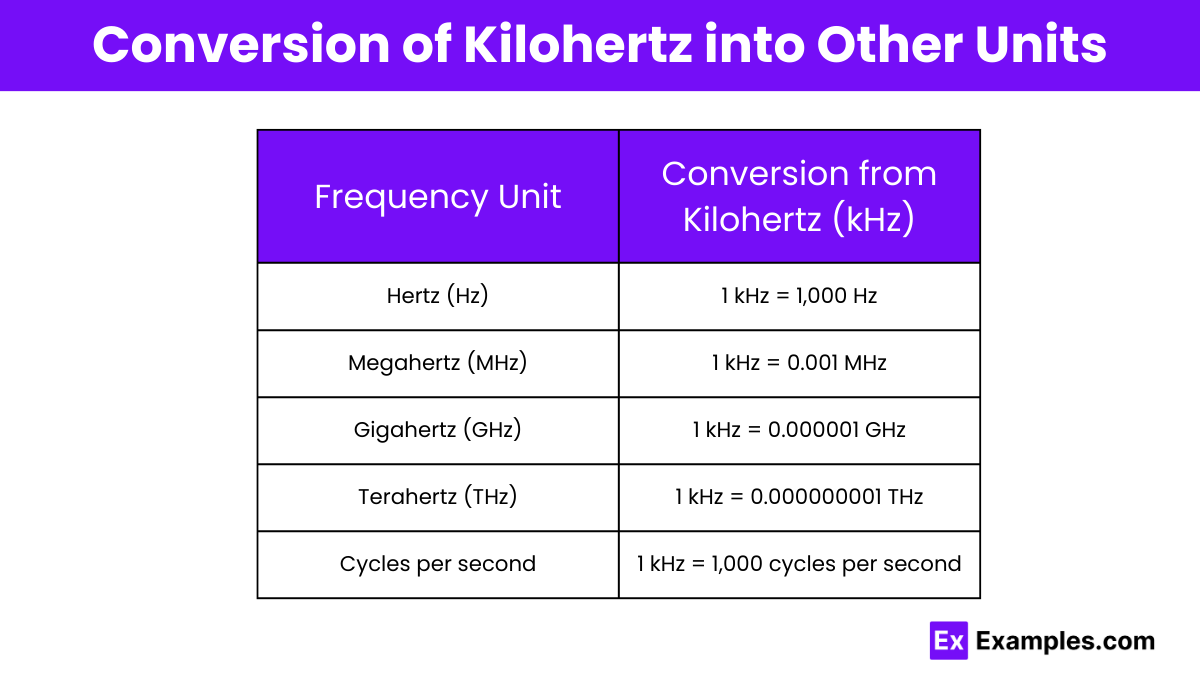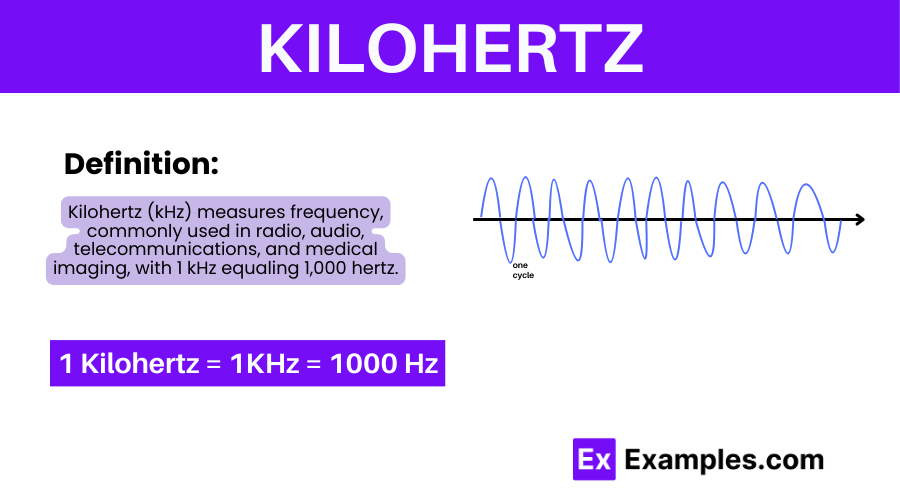Kilohertz – Formula, Differences, Usages, Examples
What is Kilohertz?
Kilohertz is a unit of frequency in the International System of Units (SI) and is used to measure the number of cycles per second of any periodic wave. One kilohertz is equal to 1,000 hertz (Hz), where one hertz represents one cycle per second.
1 Kilohertz = 1KHz = 1000 Hz
Additional Formulas Involving Kilohertz
Frequency to Period Conversion:
The period of a wave is the inverse of the frequency. To find the period T in seconds, use the formula
where f is the frequency in kilohertz. The result will be in milliseconds (ms) since 1kHz=1000Hz and T in seconds for Hz is 1/Hz .
Angular Frequency:
Angular frequency (omega, ω) is used in physics to describe the rate of rotation. It can be calculated from frequency by:
where f is the frequency in kilohertz and ω is in radians per millisecond.
Energy of a Photon (in the context of electromagnetic waves):
For electromagnetic waves, including light, the energy E of a photon can be calculated by:
where h is Planck’s constant (6.62607015×10−³⁴ Joule⋅ second) and f is the frequency in hertz. For frequency in kilohertz, ensure you convert to hertz by multiplying by 1000.
Wavelength Calculation:
The wavelength λ of a wave can be calculated if the speed c of the wave (like the speed of light for electromagnetic waves) and its frequency are known:
SI multiples of Kilohertz :
Here’s a table of SI multiples and submultiples specifically related to the kilohertz (kHz), which highlights both larger and smaller units of frequency relative to kilohertz:
| Submultiples | Multiples | ||||
|---|---|---|---|---|---|
| Value | SI Symbol | Name | Value | SI Symbol | Name |
| 10⁻¹ Hz | dHz | Decihertz | 10¹ Hz | daHz | Decahertz |
| 10⁻² Hz | cHz | Centihertz | 10² Hz | hHz | Hectohertz |
| 10⁻³ Hz | mHz | Millihertz | 10³ Hz | kHz | Kilohertz |
| 10⁻⁶ Hz | μHz | Microhertz | 10⁶ Hz | MHz | Megahertz |
| 10⁻⁹ Hz | nHz | Nanohertz | 10⁹ Hz | GHz | Gigahertz |
| 10⁻¹² Hz | pHz | Picohertz | 10¹² Hz | THz | Terahertz |
| 10⁻¹⁵ Hz | fHz | Femtohertz | 10¹⁵ Hz | PHz | Petahertz |
| 10⁻¹⁸ Hz | aHz | Attohertz | 10¹⁸ Hz | EHz | Exahertz |
| 10⁻²¹ Hz | zHz | Zeptohertz | 10²¹ Hz | ZHz | Zettahertz |
| 10⁻²⁴Hz | yHz | Yoctohertz | 10²⁴ Hz | YHz | Yottahertz |
| 10⁻²⁷ Hz | rHz | Rontohertz | 10²⁷ Hz | RHz | Ronnahertz |
| 10⁻³⁰ Hz | qHz | Quectohertz | 10³⁰ Hz | QHz | Quettahertz |
Conversion of Kilohertz into Other Units

| Frequency Unit | Conversion from Kilohertz (kHz) |
|---|---|
| Hertz (Hz) | 1 kHz = 1,000 Hz |
| Megahertz (MHz) | 1 kHz = 0.001 MHz |
| Gigahertz (GHz) | 1 kHz = 0.000001 GHz |
| Terahertz (THz) | 1 kHz = 0.000000001 THz |
| Cycles per second | 1 kHz = 1,000 cycles per second |
The kilohertz is a unit used to measure how often a periodic event, like a wave, happens in a second. One kilohertz equals one thousand times per second. When looking at larger frequencies, such as those used in radio or computer processors, we often talk in terms of megahertz or gigahertz, which represent millions and billions of cycles per second, respectively. Thus, a kilohertz is a thousandth of a megahertz and a millionth of a gigahertz. This scaling helps compare different magnitudes of frequency easily
Kilohertz to Hertz (Hz) :
One kilohertz (kHz) is equivalent to 1,000 hertz (Hz). This relationship is based on the metric system, where the prefix “kilo-” represents a thousand fold increase. Therefore, to convert from kilohertz to hertz, you simply multiply the number of kilohertz by 1,000. This conversion is useful in fields such as electronics and acoustics where frequency measurements are common.
Kilohertz to Megahertz (MHz) :
kilohertz (kHz) and megahertz (MHz) is defined by the fact that 1 kHz equals 0.001 MHz . This conversion is based on the metric prefixes where ‘kilo-‘ represents a thousand units and ‘mega-‘ represents a million units. Therefore, to convert from kHz to MHz, you divide the frequency value in kHz by 1000.
Kilohertz to Gigahertz (GHz) :
1 kilohertz (kHz) in gigahertz (GHz), you multiply by 0.000001. This relationship reflects the fact that one gigahertz equals one billion hertz, while one kilohertz equals one thousand hertz. Therefore, the conversion factor between these units is derived from the ratio of a billion to a thousand, which simplifies to 0.000001.
Kilohertz to Terahertz (THz) :
kilohertz (kHz) and terahertz (THz) is defined by the scale of the units. One kilohertz equals 0.000000001 terahertz. This reflects the exponential difference in magnitude, where one terahertz is equivalent to one trillion hertz and one kilohertz equals one thousand hertz. Thus, to convert from kHz to THz, you multiply by 10⁻⁹.
Kilohertz to Cycles per second :
he equivalence of 1 kilohertz (kHz) to 1,000 cycles per second establishes that each unit of kHz represents a frequency of 1,000 oscillations per second. This standard measurement indicates that 1 kHz, a unit used to quantify frequency, directly corresponds to a thousand cycles occurring every second, commonly used in various scientific and technological applications.
Difference between hertz and Kilohertz :
Hertz (Hz) and kilohertz (kHz) are units used to measure frequency, specifically the number of cycles or oscillations that occur per second in a wave. The main difference between the two lies in their scale: one hertz equals one cycle per second, making it the base unit of frequency in the International System of Units. In contrast, one kilohertz is equivalent to 1,000 hertz, indicating a thousand cycles per second. Thus, kilohertz is used for higher frequencies, commonly in applications involving sound frequencies, radio waves, and other areas of electronics and communications where larger frequencies are typical.
Here is a comparison between hertz (Hz) and kilohertz (kHz) presented in a table format:
| Feature | Hertz (Hz) | Kilohertz (kHz) |
|---|---|---|
| Definition | The unit of frequency measuring the number of cycles or oscillations per second. | Equal to 1,000 hertz, used for measuring higher frequencies. |
| Scale | Base unit of frequency in the International System of Units. | A derived unit, representing larger frequencies by incorporating the “kilo-” prefix, which denotes a thousand units. |
| Applications | Typically used for lower frequencies such as the ticking of a clock or the frequency of household electricity (usually 50 or 60 Hz). | Commonly used in applications involving higher frequencies such as sound frequencies in telecommunications, radio transmissions, and various fields of electronics. |
| Symbol | Hz | kHz |
What are the Uses Kilohertz?

- Audio and Acoustics:
- In audio technology, kilohertz is used to measure the frequency of sound waves. Human hearing typically ranges from 20 Hz to about 20 kHz. Audio equipment, such as speakers and microphones, often operates within this range to accommodate the human auditory spectrum.
- Radio Frequencies:
- Radio transmissions, including AM and FM radio, utilize kilohertz and megahertz to denote transmission frequencies. AM radio stations are commonly identified by their frequencies in kilohertz.
- Telecommunications:
- Kilohertz is used in the modulation of signals for telephone transmissions. The bandwidth required for voice communications typically falls within the kilohertz range, ensuring clarity and reliability in signal transmission.
- Ultrasound:
- Medical ultrasound imaging uses frequencies in the range of kilohertz to megahertz to create images of organs and other internal body structures. Lower kilohertz frequencies are used for deeper penetration in ultrasound imaging.
- Seismology:
- In seismology, sensors often measure ground movements in kilohertz to detect and analyze seismic activity. These measurements help in the understanding and prediction of earthquakes.
- Electronic Devices:
- Many electronic devices, including computers and TVs, use clocks and oscillators that operate in the kilohertz range to control timing and operation of circuits.
- Scientific Instruments:
- Spectrometers and other scientific instruments use frequencies in the kilohertz range for analyzing materials and detecting various properties based on wave interactions.
- Sonar and Radar:
- Sonar systems, used underwater, and radar systems, used in aerial and terrestrial navigation, operate using frequencies in the kilohertz range. These systems rely on the reflection of waves to detect objects and map environments.
FAQ’S
Is kHz bigger than Hz?
Yes, kHz (kilohertz) is bigger than Hz (hertz). The prefix “kilo-” means a thousand times. Therefore, 1 kilohertz (kHz) equals 1,000 hertz (Hz).
What is the unit of kHz?
The unit represented by kHz is kilohertz, which is a unit of frequency. It indicates the number of cycles per second and is typically used to measure wave frequencies, such as sound waves and electromagnetic waves.
Where is kilohertz used?
Kilohertz is commonly used in various applications including radio frequencies, sound frequencies in acoustics, and in describing the clock speeds of computer processors and other electronic devices. It helps in specifying the frequency of repetitive processes or oscillations in electronics and communications.
Is kHz an SI unit?
Yes, kHz is considered an SI (International System of Units) derived unit for measuring frequency. While hertz is the base unit in the SI system for frequency, kilohertz is simply a multiple of hertz, using the standard SI prefix “kilo-” to denote a thousand hertz.



